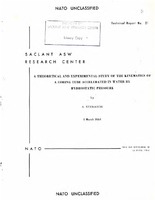| dc.contributor.author | Kermabon, André | |
| dc.date.accessioned | 2018-10-11T14:07:05Z | |
| dc.date.available | 2018-10-11T14:07:05Z | |
| dc.date.issued | 1964/03 | |
| dc.identifier | 2332 | |
| dc.identifier.govdoc | TR-21 | |
| dc.identifier.uri | http://hdl.handle.net/20.500.12489/325 | |
| dc.description.abstract | The implosion at great marine depths of a system composed of a light tube, which is closed at one end by a light cap and at the other by a heavy piston, is examined theoretically and experimentally. Special attention has been given to the downward acceleration of the tube. This accelerated tube can be used to core deep sea sediments, and a study of the penetration of the tube in normal sediments has been made. With this new coring device, it should be possible to obtain long cores with relatively light equipment. A small scale model has been tested; it has given encouraging results. Sea tests of a full scale prototype have just started. Some technological details are given, but the present design will be subject to many improvements and changes. | |
| dc.format | 46 p. : ill. | |
| dc.language | English | |
| dc.publisher | NATO. SACLANTCEN | |
| dc.relation.ispartofseries | AD0808760 | |
| dc.subject | Core and grabs | |
| dc.subject | Oceanographic equipment | |
| dc.title | A theoretical and experimental study of the kinematics of a coring tube accelerated in water by hydrostatic pressure | |
| dc.type | Scientific Technical reports (TR) | |
